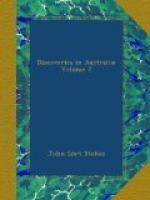October 19.
After the noon observation another attempt was made to find a passage to the westward; but at the end of eighteen miles we found ourselves embayed among patches of ripplings and breakers. The western sandhills, seen yesterday, bore at this time South by East fifteen miles. Two-thirds of the distance from the shore was a continued line of broken water. Finding, by sounding with the boats, that there was no passage for the ship, we retraced our track east; and in the evening anchored again in 7 fathoms, between two ridges of 4.
AMPHINOME SHOALS.
The outer breaker of the Amphinome Shoals bore North 37 degrees West three miles, which placed it in latitude 19 degrees 41 minutes South and longitude 119 degrees 24 minutes East; and as these shoals extend eighteen miles off such low land, they may fairly be considered dangerous.
BEDOUT ISLAND.
Next evening we anchored off the east side of Bedout Island, having, in the morning, nineteen miles to the east of it and twenty-two from the mainland, passed over a ridge of 5 fathoms.
October 21.
We spent the day on Bedout, the centre of which we found to be in latitude 19 degrees 35 minutes 45 seconds South, longitude 119 degrees 08 minutes 45 seconds East. It is a circular sand islet twenty feet high, and half a mile in extent. Off its western side ripplings and rocks extend nearly three miles; in other parts it is fronted by a circular reef a mile in extent, and of a different kind from the Turtle Isle reefs, being composed of live corallines and fan-like leaves, which giving way readily to the feet, we suddenly found ourselves immersed almost up to our necks; within fifty yards of the island this became worse. The reefs and beaches abounded with turtles of two kinds, the Mydas and a species of the Imbricated. We were in time for the noddy’s eggs; but the other birds had hatched theirs, and left for sea, returning only at night. From their great abundance and constant visits they had formed a kind of guano on the island. Among the varieties of the feathered tribe was the golden plover.
On the following afternoon we stood over, South-South-East for the main; but were again prevented by shoal water from approaching within twelve miles of the nearest part, which was the western point of the bay seen from Mount Blaze. Broken water and dry sands extended between south and east, and to the south-west the entrance of Breaker Inlet and other parts of the last year’s survey were readily distinguished.
October 22.
During the forenoon the boats completed the soundings, and in the evening the ship was anchored under the North Turtle Isle. Thus terminated the examination of this hitherto unexplored part of the coast, which had been the field of many years’ speculation. One of the most remarkable points, is the great rise of twenty-eight feet in the tide, which can only be accounted for by the fact of the water being heaped up in the concavity formed by the coast; on the first part of the bight the direction of the flood was from West, and on the latter from West-North-West. We had found that no river or other interesting feature existed; and that it was the most dull and uniform portion of the continent we had seen, or that could possibly be imagined.




